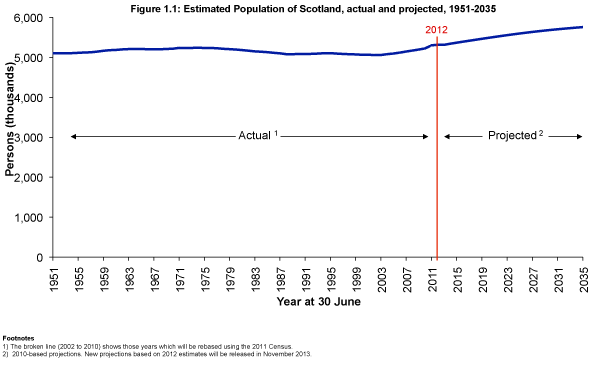
The latest estimate of Scotland's population (on 30 June 2012) is 5,313,600 - the highest ever and an increase of 13,700 people on the previous year and 18,200 people since the 2011 Census which was held on 27 March 2011.
The current increase in Scotland's population has been driven mostly by net in-migration although there have also been more births than deaths. In the 12 months to 30 June 2012, in-migration exceeded out-migration by 12,700. This included a net gain of around 3,000 from the rest of the UK and a net gain of around 9,700 from overseas (including asylum seekers). Other changes, from people joining and leaving the armed forces and changes in prisoner numbers, resulted in a net loss of around 3,300. In the same period, there were 4,223 more births than deaths (58,458 births and 54,235 deaths), continuing the recent trend in positive natural change which began in 2007.
Mid-2011 and mid-2012 population estimates have been created from rolling forward the 2011 Census. The estimates for 2002 to 2010 are based on the 2001 Census and they will be rebased to include information from the 2011 Census in December 2013.
The increase in Scotland's population in the last ten years, and projected changes over the next two decades, should be seen in the context of the relative stability of the population over the last 50 years, as shown in Figure 1.1. The population increased to 5.24 million in 1974 before decreasing to 5.05 million in 2002 and then increasing again over the last ten years achieving the highest estimate so far, 5.31 million, in 2012.
Figure 1.1: Estimated population of Scotland, actual and projected, 1951-2035

Figure 1.2 shows the trends in natural change (births minus deaths) and migration. Between 1963 and 1975, both natural change and net out-migration fell dramatically, although the natural increase generally remained greater than net out-migration. This resulted in a growth in population up to 1974. From that point on, through the late 1970s and the 1980s, up until 1989, net out-migration was higher than the natural increase, causing the population to decline. In recent years the trend in natural change has reversed and Scotland has experienced record levels of net in-migration resulting in small increases in the population over each of the last ten years. 2012 continued this trend in natural change but saw a fall in net in-migration. The net fall is driven by falling in-migration and rising out-migration over the year.
Figure 1.2: Natural change and net migration, 1951-2012
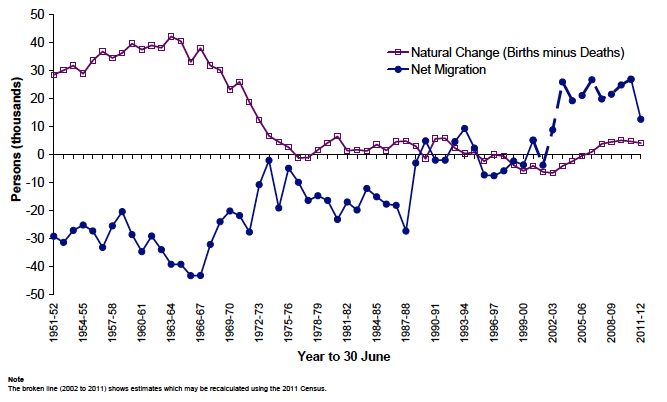
Age Structure
Composition by age and sex is one of the most important aspects of the population, as changes in the number of men and women in different age groups will have different social and economic impacts. For example, increases in the elderly population are likely to place a greater demand on health and social services.
Figure 1.3 shows the age structure of the population in 2012. Seventeen per cent of the population was aged under 16; 65% was aged 16 to 64 and 17% was aged 65 and over. Amongst older people, particularly those aged over 75, the higher number of females reflects the longer expectation of life for women, partly as a result of male mortality rates during the Second World War. The sharp peak at age 65, and the bigger bulge between the ages of around 40 and 50, are the result of the two baby booms of 1947 and the 1960s. The smaller bulge between 20 and 30, which is known as the echo effect, is the children of the baby boomers.
Figure 1.3: Estimated population by age and sex, 30 June 2012
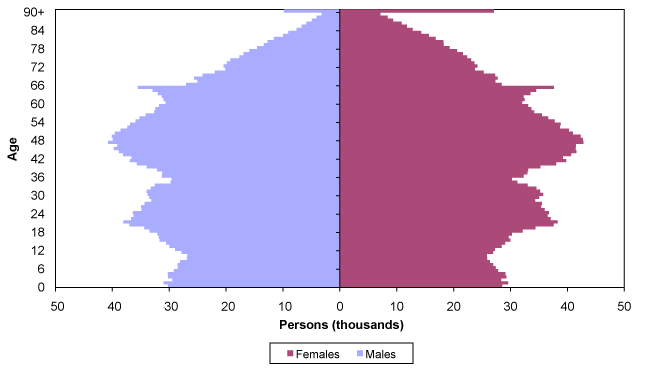
The changing age structure of Scotland's population over the ten years mid-2001 to mid-2011 is illustrated in Figure 1.4. Data from mid-2001 to mid-2011 is used because data from mid-2002 to mid-2012 is unsuitable for comparison due to the need to rebase the estimates for mid-2002. During this period the population increased by 235,700 (+4.7%), from 5.06 million to 5.30 million. The ageing of the population is evident from the decrease in population aged under 16 (-6%) and the increase of those aged 45-59 (+14%), those aged 60-74 (+16%) and those aged over 75 (+14%).
Figure 1.4: The changing age structure of Scotland's population, 2001-2011
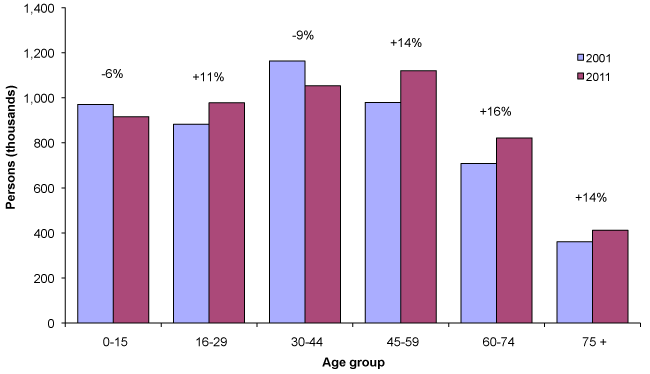
Changes within Scotland
The map at Figure 1.5 shows the percentage change in population between 2011 and 2012 for each council area.
The council area with the greatest decrease in population was Argyll & Bute where the population declined by 2,030 (-2.3%); most of this fall was due to changes in armed forces personnel. Aberdeen City (+1.1%) and the City of Edinburgh (+1.0%) saw the greatest percentage increases, while the largest increase in absolute numbers was in the City of Edinburgh (+4,700).
Figure 1.5: Percentage population change by Council area, Mid-2011 to Mid-2012
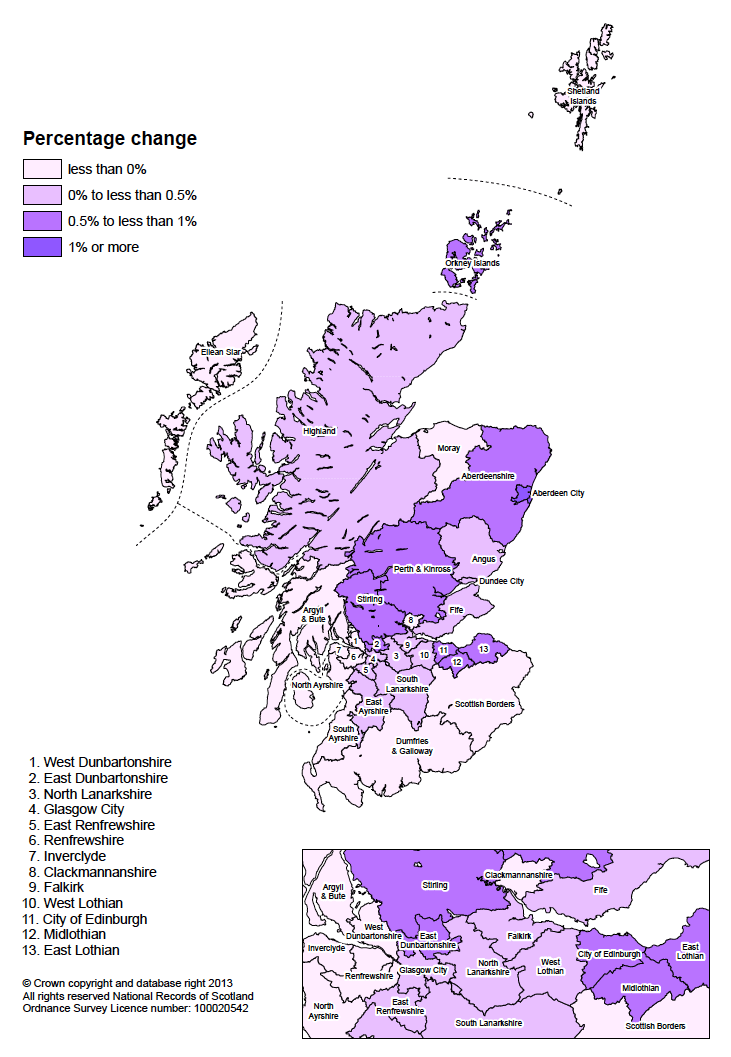
The relative importance of migration and natural change differs between areas. In some areas of population increase, such as the City of Edinburgh, Midlothian and Aberdeen City, the gain is attributable both to migration and to natural increase. East Dunbartonshire, the Orkney Islands and Stirling experienced a population increase because of in-migration combined with a very low natural change. In other areas, the population increase is due to in-migration, despite the number of deaths exceeding the number of births. These included Perth & Kinross and Angus.
Similarly, some areas of population decline, such as Inverclyde, Moray and Argyll & Bute have experienced population decreases from natural change, migration and other changes. In other areas such as Eilean Siar and the Scottish Borders the population decline was mainly attributable to more deaths than births. This analysis is shown in Table 1.1, which compares percentage change in population due to natural change and migration across the Council areas.
Table 1.1: Components of population change for Council areas: Mid-2011
to Mid-2012
| Natural change 1 | Net civilian migration and other changes 1 | Percentage population change | |
|---|---|---|---|
| SCOTLAND | 0.08 | 0.2 | 0.3 |
| Council areas2 | |||
| Aberdeen City | 0.3 | 0.8 | 1.1 |
| Edinburgh, City of | 0.2 | 0.7 | 1.0 |
| Midlothian | 0.3 | 0.7 | 0.9 |
| East Lothian | 0.2 | 0.8 | 0.9 |
| East Dunbartonshire | 0.0 | 0.9 | 0.8 |
| Stirling | 0.0 | 0.7 | 0.8 |
| Aberdeenshire | 0.2 | 0.5 | 0.7 |
| Perth & Kinross | -0.1 | 0.7 | 0.6 |
| Orkney Islands | 0.0 | 0.5 | 0.5 |
| Dundee City | 0.1 | 0.3 | 0.4 |
| West Lothian | 0.3 | 0.0 | 0.4 |
| Falkirk | 0.2 | 0.2 | 0.4 |
| Glasgow City | 0.2 | 0.1 | 0.3 |
| Fife | 0.1 | 0.2 | 0.3 |
| East Renfrewshire | 0.1 | 0.2 | 0.2 |
| South Lanarkshire | 0.0 | 0.1 | 0.1 |
| Highland | 0.0 | 0.1 | 0.1 |
| North Lanarkshire | 0.2 | -0.1 | 0.0 |
| East Ayrshire | 0.1 | -0.1 | 0.0 |
| Angus | -0.1 | 0.1 | 0.0 |
| South Ayrshire | -0.3 | 0.3 | -0.1 |
| Shetland Islands | 0.2 | -0.3 | -0.1 |
| Scottish Borders | -0.2 | 0.0 | -0.1 |
| Renfrewshire | 0.0 | -0.2 | -0.2 |
| West Dunbartonshire | 0.0 | -0.3 | -0.3 |
| Dumfries & Galloway | -0.3 | -0.1 | -0.4 |
| North Ayrshire | 0.0 | -0.3 | -0.4 |
| Clackmannanshire | 0.3 | -0.7 | -0.4 |
| Eilean Siar | -0.5 | 0.0 | -0.5 |
| Moray | -0.1 | -0.5 | -0.6 |
| Inverclyde | -0.3 | -0.4 | -0.7 |
| Argyll & Bute | -0.3 | -2.0 | -2.3 |
1) Change per 100 population at mid-2011. The underlying data used to produce these figures can be found in Table 4c of the 'Mid-2011 and Mid-2012 Population Estimates Scotland' publication.
2) Ordered by population change.
Projected population
The latest published projections of Scotland's future population are based on the estimate of Scotland's population in June 2010 and are therefore based on the 2001 Census results rather than the 2011 Census results. All the population estimates presented in this section are based on the 2001 Census. New national projections based on the mid-2012 population estimates rolled-forward from the 2011 Census estimates will be published in November 2013.
The projections, based on existing trends of migration and natural change and making no allowance for the future impact of government policies and other factors, such as the upcoming referendum on Scottish Independence, show the total population of Scotland rising from 5.22 million in 2010 to 5.76 million in 2035 (Figure 1.1).
As demographic behaviour is uncertain, a number of variant projections of the future population have been calculated, based on alternative assumptions of future fertility, mortality and migration, in addition to the 'principal projection' on which the previous paragraphs are based. The variant projections give users an indication of this uncertainty. They illustrate plausible alternative scenarios, rather than representing upper or lower limits of future demographic behaviour. These variant projections, and the assumptions used, can be found in the taxonomy section of the Office for National Statistics website.
For the principal projection until 2028, natural change and migration both act to increase the size of the population as the number of births exceeds the number of deaths and there is net in-migration. After that point, the number of deaths exceeds the number of births, a consequence of the ageing of the population, whilst the net migration into Scotland continues. Figure 1.6 shows the historical and projected future trends of births and deaths in Scotland.
Figure 1.6: Births and deaths, actual and projected, Scotland, 1951-2035
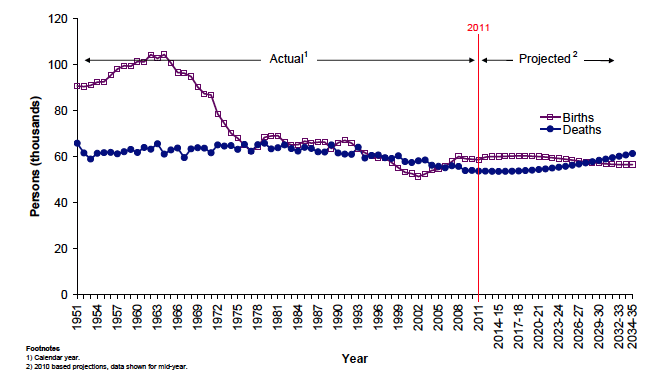
Between 2010 and 2035, Scotland's population is projected to age significantly. As shown in Figure 1.7, the number of children aged under 16 is projected to rise only by 3%, from 0.91 million to 0.94 million. The number of people aged 65 and over is projected to rise by 63%, from 0.88 million to 1.43 million.
Figure 1.7: The projected percentage change in age structure of Scotland's population, 2010-2035
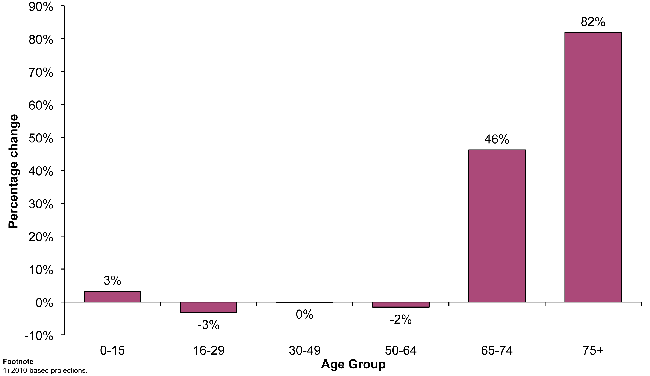
Another way of looking at the age structure of the population is to look at dependency ratios. Dependency ratios can be defined in different ways.
Here three are calculated:
These ratios should be interpreted with care. For example, a simple interpretation is the number of older people or children who are 'dependent' on people aged 16 to state pension age, the assumption being that most older people and children are not economically active. The reality is of course much more complex, since (to give just a few reasons) many people of typically working age are unemployed or economically inactive (e.g. at school or university), the age at which people retire varies greatly and many retired people are financially independent. However, these 'dependency' ratios provide a useful way to examine the relative age structure of the population.
Figure 1.8, which takes account of the increase in the state pension age for both men and women[1], shows little change in these ratios over the next 15-20 years, but a fairly rapid increase in the pension age population relative to the working age population in subsequent years. This starts to slow down in 2035 due to changes in state pension age.
Figure 1.8: Dependency ratios (per thousand working population), 2010-2035
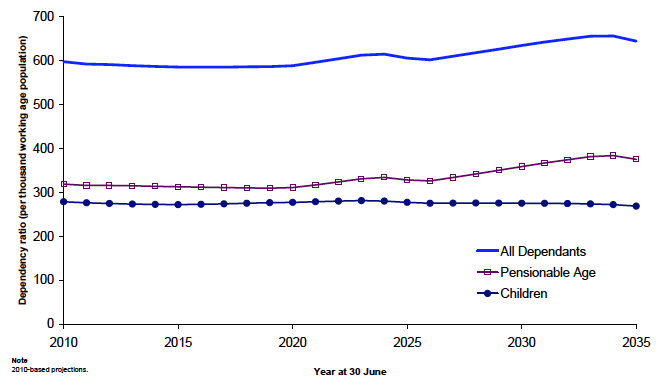
Scotland's position within the European Union (EU)
The population of most of the countries in Europe is projected to increase over the next few years. Scotland's population is projected to rise by 10% between 2010 and 2035. The population of Europe[2] (EU-27[3]) is projected to increase by 4.7% while the rest of the UK, and certain countries such as Ireland, are projected to have much bigger increases. However Germany as well as a number of Central and Eastern European Countries (CEECs[3]), are projecting a population decline as Figure 1.9 shows.
Figure 1.9: Projected percentage population change in selected European countries 2010-2035
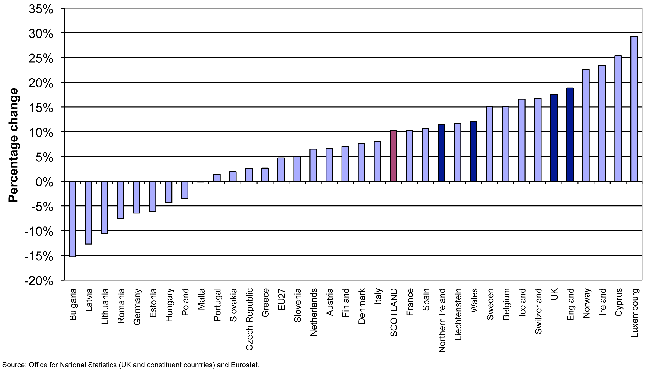
Scotland is not alone in having an ageing population. The pattern of change over the last 20 years, and the projected change in the age distribution, is similar to that of other countries in the UK and Europe, although the rate of change varies.
More information about population statistics
More detailed information about Scotland's population, including estimates, projections at national and sub-Scotland level, as well as estimates of specific population groups, can be found in the population section of the National Records of Scotland (NRS) website.
A reconciliation report examining the differences between the 2011 Census Day estimates and the population estimates that were rolled-forward from the 2001 Census can also be found in the households section of the NRS website.
Rebased population estimates for the years mid-2002 to mid-2010 at council and NHS Board area level will be published in December 2013, Small Area Population Estimates for 2011 and 2012 will also be published in December 2013.